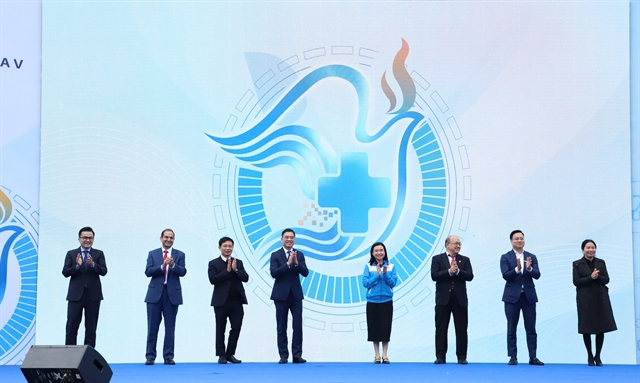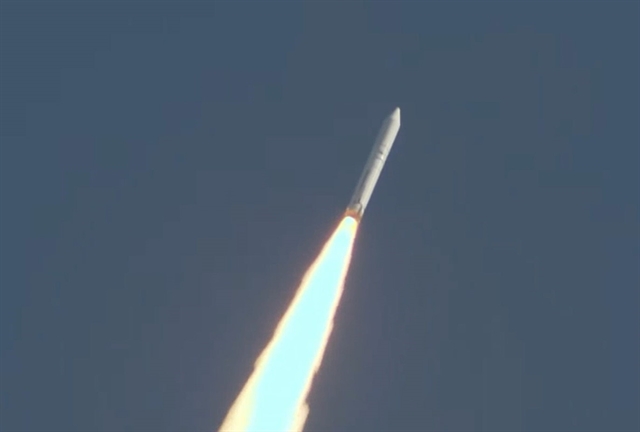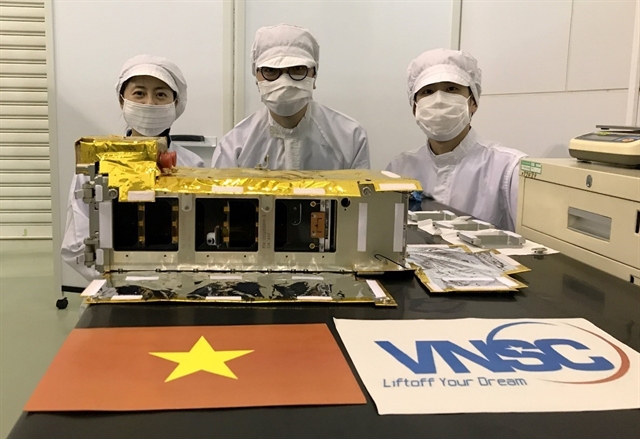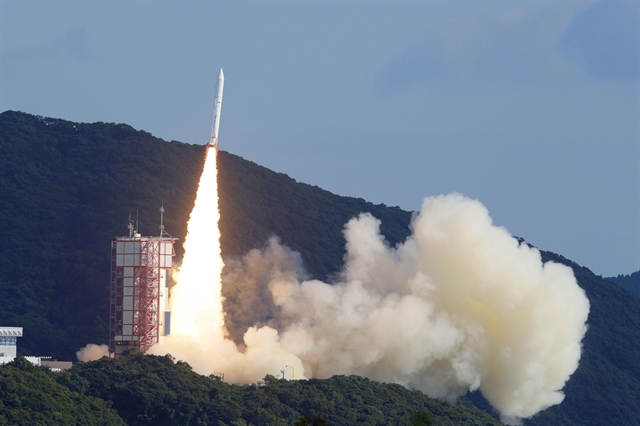 Society
Society

NanoDragon, the first satellite made entirely by Vietnamese engineers, lifted off from the Uchinoura Space Center in Japan on Tuesday.

|
| The Epsilon 5 rocket blasted into space from the Japanese town of Kimotsuki, Kagoshima Prefecture at 7.55am Hà Nội time. — VNA/VNS Photos Đào Thanh Tùng |
KAGOSHIMA — NanoDragon, the first satellite made entirely by Vietnamese engineers, lifted off from the Uchinoura Space Center in Japan on Tuesday.
After three previous failed launch attempts due to a combination of bad weather and technical problems, at 7.55am local time the Epsilon 5 rocket blasted into space from the Japanese town of Kimotsuki, Kagoshima Prefecture.
On board the rocket, NanoDragon was due to separate and go into orbit at 9:07 (local time).
NanoDragon, which is 100x100x340,5mm in size and weighs 3.8kg, is the first satellite that is researched, designed and manufactured entirely in Việt Nam.
Vũ Hồng Nam, Vietnamese Ambassador to Japan said “It’s touching to witness the historic moment when Japan’s Epsilon 5 carrying our satellite NanoDragon was launched into the orbit.
“It’s great to see the achievements of Việt Nam’s space industry. The launch of this satellite has significant meaning, showing a great stride that Vietnamese engineers have made in designing and manufacturing satellites.”
“It also affirms the determination of our country in developing the space industry.”

|
| Epsilon 5 carries nine satellites, making Tuesday's mission the largest undertaken by Epsilon to date. |
General Director of the Việt Nam National Space Centre Phạm Anh Tuấn added: “NanoDragon is a research satellite with a number of benefits.
“It can be used to receive signals to identify vessels, through AIS (Automatic Identification System) to avoid collisions or to monitor vessels and vehicles at sea. From this, we can consider using micro satellites with similar features to NanoDragon for related services and activities.
“This is also an opportunity for us to accumulate experience, develop a team, establish a supplier network, improve the process and it can serve as the foundation for the development of other made-in-Vietnam satellites.”
According to Tuấn, Việt Nam started studying space science and technology since the 1980s. But it only focused on such fields as satellite technology in 2006 to implement the strategy for research and application of space technology until 2020.

|
| Japanese engineers check Vietnamese satellite before the launch. |
Việt Nam has achieved certain results in its space industry which include launching two telecommunications satellites, an earth observation satellite and systems of satellite receivers and control stations, and developing three small satellites namely PicoDragon, MicroDragon and NanoDragon.
The Việt Nam National Space Centre is established with three main tasks: establishing technical infrastructure, training highly qualified staff and receiving satellite technology transfer towards the goal of mastering the satellite development technology, according to the head of the centre.
Currently there is no specific standard to measure the level of space technology development of countries, but one can classify according to some milestones such as: countries with independent orbital launch capabilities, those that own satellites in orbit, and those that do not yet own satellites.
Việt Nam owns six satellites operating in orbit, including two telecommunications satellites and an earth observation satellite and three research satellites.
Among them, three were bought from commercial companies around the world and three satellites were developed by Vietnamese engineers.
The satellite is part of a national research project on space technology in 2016-2020 conducted by the Việt Nam National Space Center (VNSC).
Previously, two other satellites were sent to orbit but they were created with the assistance of engineers from Japan.
NanoDragon was among nine satellites carried by the Epsilon 5 rocket, which measures 2.6m in diameter, 26m in length and weighs 96 tonnes. Tuesday's mission was the largest undertaken by Epsilon to date.
The Vietnamese satellite is tasked with two important missions: checking the entry and exit of vessels through AIS (Automatic Identification System), and taking aerial photos to help scientists perfect satellite navigation systems.

|
| NanoDragon is the first satellite developed entirely by Vietnamese engineers. |
Challenges for Việt Nam’s space industry
The limited access to components and high cost of material are among challenges in developing satellites in Việt Nam.
Tuấn said: "Satellites operate in extremely harsh environments characterised by factors like high vacuum, weightlessness, high energy rays and particles, which are completely different from the environment on the ground.
“Satellites work in special environments and conditions, so they need strict and good quality management and monitoring process.
“The components on the satellite need to be small in weight and size, highly efficient, and capable of operating in harsh environments. Those are high-tech products and often used in the defence industry, so access to these products is limited and that leads to high cost.
“For Việt Nam, we also have to face other challenges such as lack of human resources and infrastructure, low investment, limited awareness of satellite technology which then affect the participation of economic sectors in the supply chain.”
The infrastructure of the Việt Nam National Space Center is still limited with a lack of a complete system with a research centre, ground station and testing equipment.
The fund for research and development of satellites is also limited as the budget is for manufacturing satellites only and other costs like launching the satellite are not included, according to Tuấn.
"Việt Nam is also among ITAR (International Traffic in Arms Regulations) Prohibited Countries so we cannot access certain types of high-tech products," Tuấn said.
“The supporting industry in Việt Nam is also limited. Small companies' technical level is still weak while companies with good technology are often not interested in manufacturing single products with low profit margin,” he added. — VNS

|
| The Epsilon-5 rocket carrying nine satellites, including Việt Nam's NanoDragon lifts off from Uchinoura Space Center in Kagoshima Prefecture, Japan, on Tuesday. — KYODO/VNA Photo |




